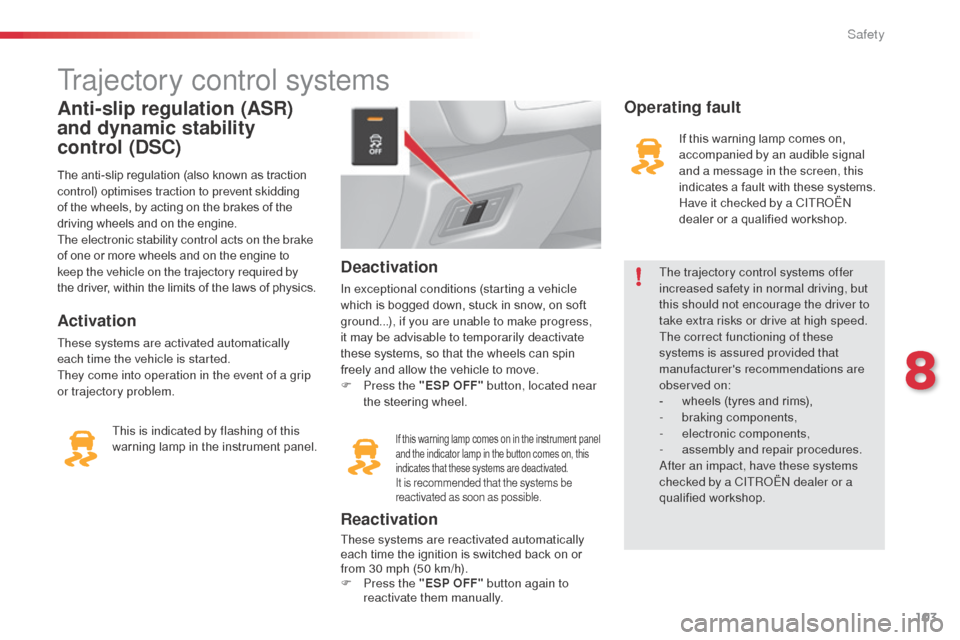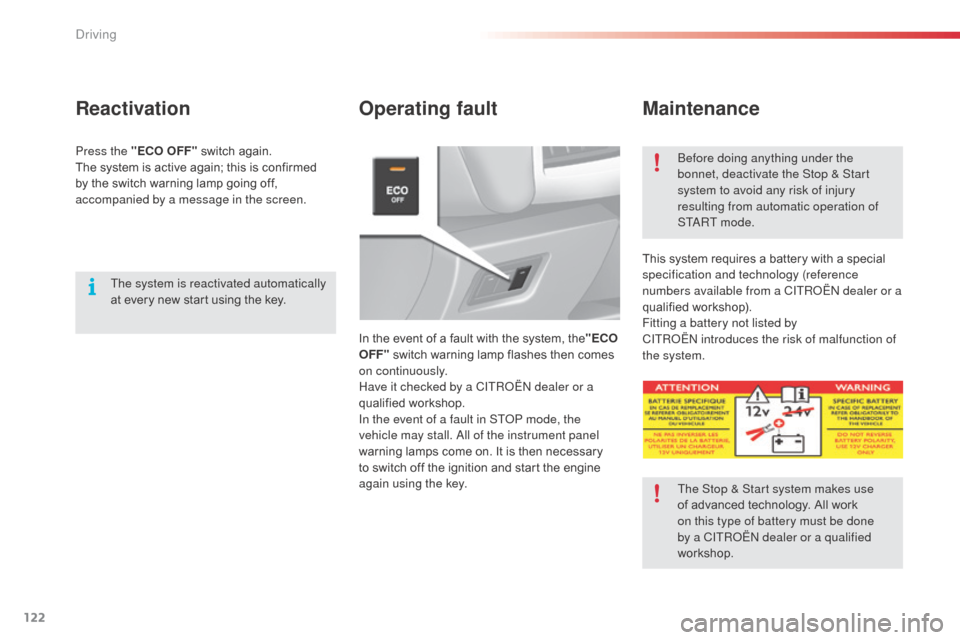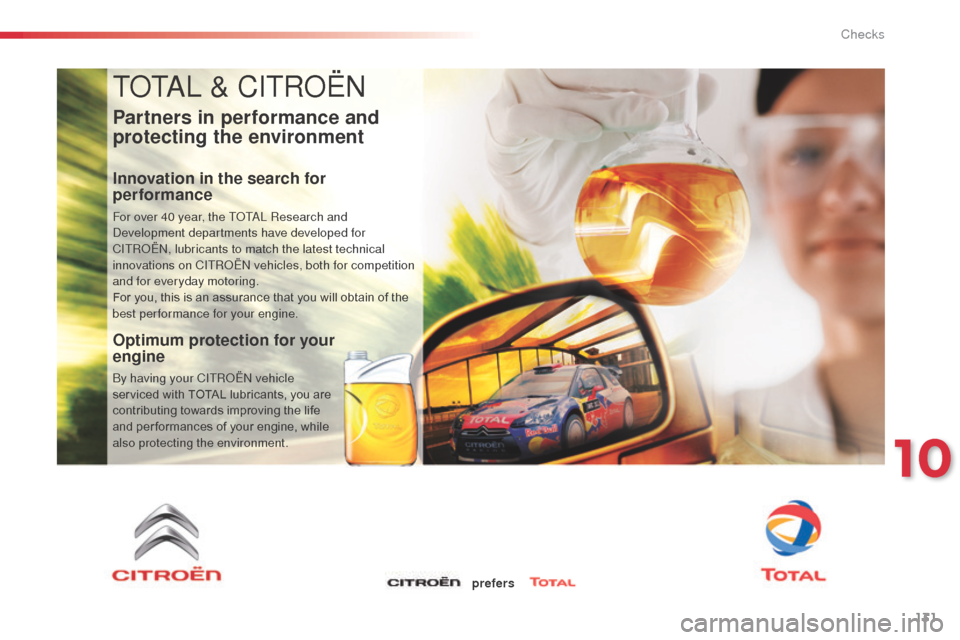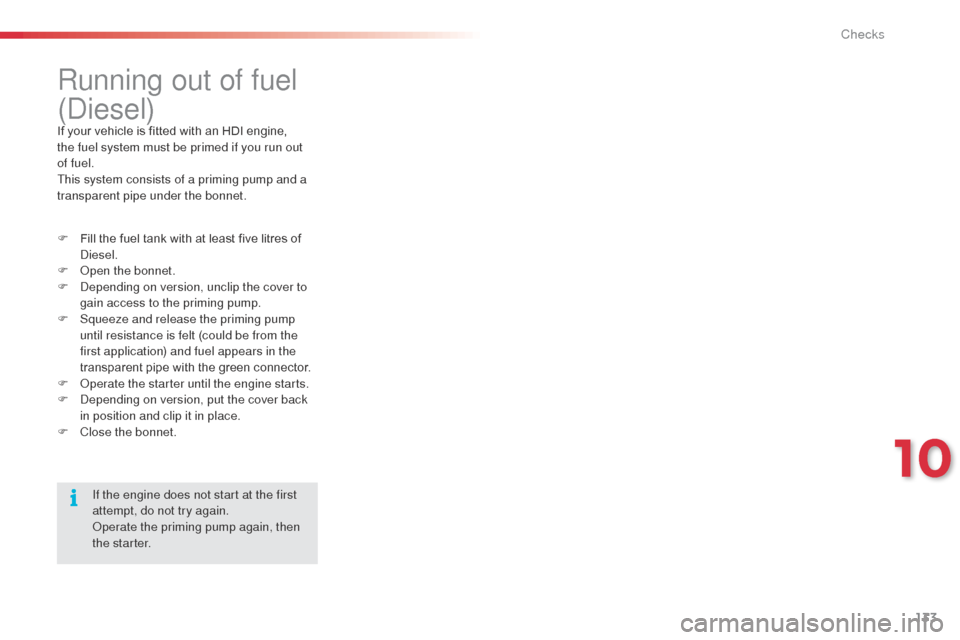check engine Citroen C3 2014 2.G User Guide
[x] Cancel search | Manufacturer: CITROEN, Model Year: 2014, Model line: C3, Model: Citroen C3 2014 2.GPages: 284, PDF Size: 9.01 MB
Page 105 of 284

103
C3_en_Chap08_Securite_ed01-2014
Trajectory control systems
Anti-slip regulation (ASR)
and dynamic stability
control (DSC)
The anti-slip regulation (also known as traction
control) optimises traction to prevent skidding
of the wheels, by acting on the brakes of the
driving wheels and on the engine.
The electronic stability control acts on the brake
of one or more wheels and on the engine to
keep the vehicle on the trajectory required by
the driver, within the limits of the laws of physics.
Activation
These systems are activated automatically
each time the vehicle is started.
They come into operation in the event of a grip
or trajectory problem.This is indicated by flashing of this
warning lamp in the instrument panel.
Deactivation
In exceptional conditions (starting a vehicle
which is bogged down, stuck in snow, on soft
ground...), if you are unable to make progress,
it may be advisable to temporarily deactivate
these systems, so that the wheels can spin
freely and allow the vehicle to move.
F
P
ress the "ESP OFF" button, located near
the steering wheel.
If this warning lamp comes on in the instrument panel
and the indicator lamp in the button comes on, this
indicates that these systems are deactivated.
It is recommended that the systems be
reactivated as soon as possible.
Reactivation
These systems are reactivated automatically
each time the ignition is switched back on or
from 30 mph (50 km/h).
F
P
ress the "ESP OFF" button again to
reactivate them manually.
Operating fault
If this warning lamp comes on,
accompanied by an audible signal
and a message in the screen, this
indicates a fault with these systems.
Have it checked by a CITR
oËn
dealer or a qualified workshop.
The trajectory control systems offer
increased safety in normal driving, but
this should not encourage the driver to
take extra risks or drive at high speed.
The correct functioning of these
systems is assured provided that
manufacturer's recommendations are
observed on:
-
w
heels (tyres and rims),
-
b
raking components,
-
el
ectronic components,
-
a
ssembly and repair procedures.
af
ter an impact, have these systems
checked by a CITR
oËn
dealer or a
qualified workshop.
8
Safety
Page 116 of 284

114
C3_en_Chap09_Conduite_ed01-2014
C3_en_Chap09_Conduite_ed01-2014
In exceptional circumstances, the
gearbox may need an automatic
reinitialisation: starting and gear
changing are no longer possible.
Reverse
To engage reverse, the vehicle must be
immobilised with your foot on the brake.
F
Sel
ect position R .
Operating fault
With the ignition on, if this warning
lamp comes on and AUTO flashes,
accompanied by an audible signal
and a message in the multifunction
screen, this indicates a gearbox
fault.
Have it checked by a CITR
oËn
dealer or a qualified workshop.
At low speed, if reverse gear is requested,
the N warning lamp flashes and the gearbox
goes into neutral automatically.
To engage reverse, put the gear lever into
position N
, then to position R .Stopping the vehicle
Before switching off the engine:
-
c hange to position N to be in neutral,
or
-
l
eave the vehicle in gear; in this case the
vehicle cannot be moved.
Reinitialisation
(5-speed electronic
gearbox)
Following disconnection of the battery, it is
necessary to reinitialise the gearbox.
F
S
witch on the ignition.AUTO and - - appear in the
instrument panel.
F
Sel
ect position N .
F
P
ress the brake pedal.
F
W
ait for around 30 seconds until N or a
gear appears in the instrument panel.
F
M
ove the gear lever to position A , then to
position N .
F
W
ith your foot still on the brake pedal, start
the engine.
The gearbox is operational again. AUTO
and - - appear in the
instrument panel.
Follow the procedure described above.
be
fore doing anything under the
bonnet, ensure that the gear lever is in
neutral (position N ) and that the parking
brake is applied.
There is an audible signal on
engagement of reverse.
For all parking situations, you must
apply the parking brake
to immobilise
the vehicle. When immobilising the vehicle with the
engine running, you must put the gear
lever into neutral (position N
).
driving
Page 124 of 284

122
C3_en_Chap09_Conduite_ed01-2014
C3_en_Chap09_Conduite_ed01-2014
Operating faultMaintenance
In the event of a fault with the system, the "ECO
OFF" switch warning lamp flashes then comes
on continuously.
Have it checked by a CITR
oËn
dealer or a
qualified workshop.
In the event of a fault in ST
oP m
ode, the
vehicle may stall.
a
l
l of the instrument panel
warning lamps come on. It is then necessary
to switch off the ignition and start the engine
again using the key. This system requires a battery with a special
specification and technology (reference
numbers available from a CITR
oËn
dealer or a
qualified workshop).
Fitting a battery not listed by
CITRoËn introduces the risk of malfunction of
the system.
Press the "ECO OFF" switch again.
The system is active again; this is confirmed
by the switch warning lamp going off,
accompanied by a message in the screen.
be
fore doing anything under the
bonnet, deactivate the Stop & Start
system to avoid any risk of injury
resulting from automatic operation of
S T a
R
T m o d e .
The system is reactivated automatically
at every new start using the key.
The Stop & Start system makes use
of advanced technology. All work
on this type of battery must be done
by a CITR
oËn
dealer or a qualified
workshop.
Reactivation
driving
Page 125 of 284

123
C3_en_Chap09_Conduite_ed01-2014
C3_en_Chap09_Conduite_ed01-2014
Hill start assist
System which holds your vehicle temporarily
(approximately 2 seconds) when starting on a
slope, the time it takes to move your foot from
the brake pedal to the accelerator pedal.
This function is only active when:
-
t
he vehicle is completely stationary, with
your foot on the brake pedal,
-
c
ertain conditions on a slope are met,
-
w
ith the driver’s door closed.
The hill start assist function cannot be
deactivated.
On an ascending slope, with the vehicle
stationary, the vehicle is held momentarily
when you release the brake pedal:
-
p
rovided you are in automated mode
(position A ) or in manual mode (position M )
on an electronic gearbox.
Operating fault
If a malfunction of the system occurs, these
warning lamps come on. Contact a CITROËN
dealer or a qualified workshop to have the
system checked. On a descending slope, with the vehicle
stationary and reverse gear engaged, the
vehicle is held momentarily when you
release the brake pedal.
Do not leave the vehicle while it is being
held in the hill start assist phase.
If you need to leave the vehicle with
the engine running, manually apply
the parking brake then ensure that the
parking brake warning lamp is on (not
flashing) in the instrument panel.
Operation
9
driving
Page 133 of 284

131
ToTaL & CITRoËn
Partners in performance and
protecting the environment
Innovation in the search for
performance
For over 40 year, the ToTaL Research and de
velopment departments have developed for
CITR
oËn, l
ubricants to match the latest technical
innovations on CITR
oËn
vehicles, both for competition
and for everyday motoring.
For you, this is an assurance that you will obtain of the
best performance for your engine.
Optimum protection for your
engine
by having your CITRoËn vehicle
serviced with TOTAL lubricants, you are
contributing towards improving the life
and per formances of your engine, while
also protecting the environment.
prefers
10
Checks
Page 134 of 284

132
bonnetProtects the components of the engine and provides access for checking levels.
Opening
F Push the exterior safety catch B to the left and raise the bonnet. F
U
nclip the bonnet stay C from its housing,
holding it by its foam protection.
F
F
ix the stay in the notch to hold the bonnet
open. F
T
ake the stay out of the support notch.
F
C
lip the stay in its housing.
F
L
ower the bonnet and release it at the end
of its travel.
F
P
ull on the bonnet to check that it is fully
latched.
F o
p
en the front left door.
F
P
ull the interior release lever A
, located at
the bottom of the door aperture.
The location of the interior release lever
prevents opening of the bonnet while
the front left door is closed.
When the engine is hot, handle the
exterior safety catch and the stay with
care.
be
fore doing anything under the
bonnet, switch off the Stop & Start
system to avoid any risk of injury
resulting from an automatic change to
S T a
R
T m o d e .
Closing
To avoid damaging the electric units,
the use of a high pressure jet wash
under the bonnet is strictly prohibited.
Checks
Page 135 of 284

133
Running out of fuel
(
die
sel)
If your vehicle is fitted with an HDI engine,
the fuel system must be primed if you run out
of fuel.
This system consists of a priming pump and a
transparent pipe under the bonnet.
F
F
ill the fuel tank with at least five litres of
die
sel.
F
o
p
en the bonnet.
F
d
e
pending on version, unclip the cover to
gain access to the priming pump.
F
S
queeze and release the priming pump
until resistance is felt (could be from the
first application) and fuel appears in the
transparent pipe with the green connector.
F
o
p
erate the starter until the engine starts.
F
d
e
pending on version, put the cover back
in position and clip it in place.
F
C
lose the bonnet.If the engine does not start at the first
attempt, do not try again.
op
erate the priming pump again, then
the starter.
10
Checks
Page 136 of 284

134
Petrol engines
1. Screenwash fluid reservoir.
2. Coolant header tank.
3.
a
i
r f i l t e r.
4.
b
r
ake fluid reservoir.
5.
bat
tery.
6.
Fusebox.
7.
E
ngine oil dipstick.
8.
E
ngine oil filler cap.
Checks
Page 137 of 284

135
diesel engines
1. Screenwash fluid reservoir.
2. Coolant header tank.
3.
a
i
r f i l t e r.
4.
b
r
ake fluid reservoir.
5.
bat
tery.
6.
Fusebox.
7.
E
ngine oil dipstick.
8.
E
ngine oil filler cap.
9.
P
riming pump (on fuel filter).
10
Checks
Page 138 of 284

136
Checking levels
Engine oil level
The check is carried out either when
the ignition is switched on using the
oil level indicator in the instrument
panel for vehicles with an electric oil
level gauge, or using the dipstick.
Checking using the dipstick
Refer to the "Petrol engine" or "di esel engine"
section for the location of the dipstick in the
engine compartment of your vehicle.
F
T
ake the dipstick by its coloured grip and
remove it completely.
F
W
ipe the end of the dipstick using a clean
non-fluffy cloth.
F
R
efit the dipstick and push fully down, then
pull it out again to make the visual check:
the correct level is between the marks A
and B .
To ensure that the reading is correct,
your vehicle must be parked on a level
sur face with the engine having been off
for more than 30 minutes.
Check all of these levels regularly, in line with the maintenance and warranty guide. Top them up if necessary, unless other wise indicated.
If a level drops significantly, have the corresponding system checked by a CITROËN dealer or a qualified workshop.
Take care when working under the
bonnet, as certain areas of the engine
may be extremely hot (risk of burns) and
the cooling fan could start at any time
(even with the ignition off).
It is normal to top up the oil level between
two services (or oil changes). CITROËN
recommends that you check the level, and top
up if necessary, every 3 000 miles (5 000 kms). A = M
aX
B
= MI
n
I
f you find that the level is above the A mark or
below the B mark, do not star t the engine .
-
I
f the level is above the MAX mark (risk
of damage to the engine), contact a
CITROËN dealer or a qualified workshop.
-
I
f the level is below the MIN mark, you
must top up the engine oil.
Oil grade
before topping-up the oil or changing the oil,
check that the oil is the correct grade for your
engine and conforms to the manufacturer's
recommendations.
Checks